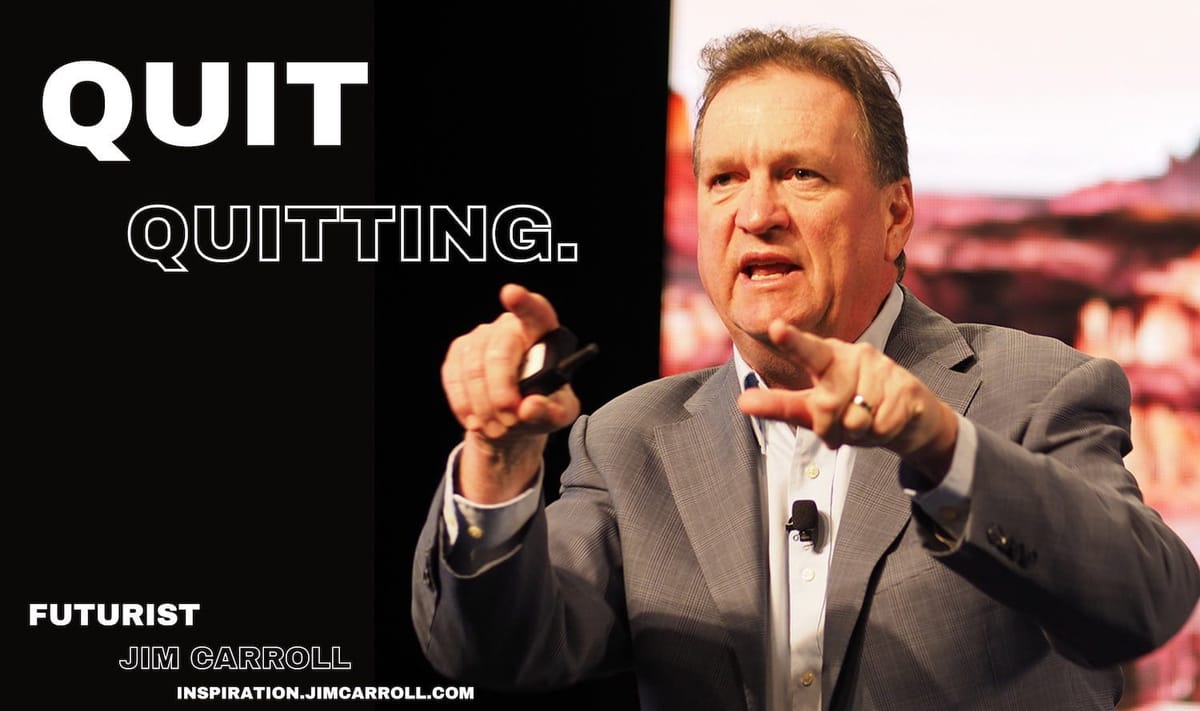Many organizations embrace failure because they always give up on trying to do the hard stuff. Many leadership teams never get their project to the finish line because they give in to the negative elements around them that are always pushing them to stop. Many individuals never get to where they could be because they simply stop trying.
Too many quit too early.
Quitting is easy; staying the course and seeing things through is hard.
That's not to say there is a benefit to be found in 'good quitting.' I've quit quite a few negative things in my life along the way, and know that quitting an effort to permanently quit something is not a great thing. Three months into our relationship in 1987, my new girlfriend suggested to me that I had a choice to make - it was either the cigarettes or her. I chose wisely - today, she is my wife. She's since seen me make a few other great decisions along the way that have involved 'good quitting.' (Perhaps I never quite understood the concept of smoking in the first place, LOL.)

I digress.
Why do people and organizations quit important things? So much of it is due to mindset - fear of failure, lack of motivation, feeling overwhelmed, or overwhelming mental exhaustion can play a role. There are other issues, such as a lack of skilled resources. Fuzzy goals, endless distractions, or a poorly constructed team with bad vibes can also engineer an early termination of a critical project. In other cases, unrealistic expectations, a budget constraint due to poor planning, or simply never understanding the scope of the project in the first place can lead to an abandonment of an effort. Often an organization will quit because a competitor has a head start, a leap on the opportunity, and was first to get out of the starting gate simply because they saw the opportunity before anyone else did.
But in other cases, it's a simple denial of the reality of the future that causes an organization to quit.
Sometimes organizations fall prey to the phrase that it is 'better to quit while you are ahead,' and often, that is exactly the wrong thing to do. Quitting early can set you back when the inevitability of the trend eventually rears its head. Which brings us to the story and the film, "Who Killed the Electric Car?" In the face of the inevitability of the electrification of vehicles, many major automotive companies are far behind, and for some of them, that is the result of a past decision to quit on an obvious future trend. Active denial in the face of an obvious future is a form of leadership negligence - quitting early is a clear leadership failure.
The video "Who Killed the Electric Car?" tells the story of how General Motors launched the EV-1 in 1997, an electric automobile that required no gas, oil, muffler, or brake changes - it was the world's first true electric car. Yet six years later, GM quit and recalled and destroyed the entire EV-1 fleet. Why? It was clinging to its current business model, working at speed to deny the future. It's a heck of a story about 'quitting.'
General Motors (GM) is aiming to create a bit of noise (not literally) in the Battery Electric Vehicle (BEV) arena with its new “electric supertruck”, the GMC Hummer EV.
But it’ll be nothing compared with its first headline-grabbing BEV, the GM EV1.
The 1996 EV1 now sounds a bit old-tech by modern standards: the first examples had lead-acid batteries and less than 100km range. But the EV1 was the first viable real-world BEV from a volume carmaker. It even predated Toyota’s petrol-electric Prius.
However, the EV1’s fame came not from its groundbreaking BEV status but from GM’s decision to cancel the programme and take back the cars from hugely enthusiastic, high-profile customers.
From the start, the EV1 was only available under lease, with lessors carefully vetted by GM. The agreement specifically excluded the possibility of purchasing the car at the end of the term.
Just 1117 first and second-generation cars were made from 1996-99. In the face of slackening legal requirements for zero-emissions vehicles in California and the high cost/limited sales of the EV1, GM officially discontinued the programme in 2002 and recalled the vehicles, with the intention of crushing them.
And that’s where the EV1 legend really began, because many owners didn’t want to give them up. GM argued the project was a fiscal failure and the cost of maintaining service and repair infrastructure for 15 years (required by law in California) was prohibitive. At least 50 lessees offered to buy their cars and agree to no liability to GM for service or repair; but the company declined.
Many lessees and EVangelists argued GM and the wider car and oil industries wanted to suppress BEV technology, as it posed a threat to profitable petrol-powered cars and the infrastructure built around them.
The controversy was captured in the 2006 documentary Who Killed the Electric Car?
Electric Car That Made Everyone Made,
20 November 2020, Hawke's Bay Today
Watch the "six-minute version" of the documentary, edited for quick consumption, to learn more. You can find the full documentary on most streaming services.
It's a sad story, and the result today is all too predictable - GM squandered an early lead, and today, is well behind in one of the most significant trends of our time. By quitting while it was ahead, GM fell far behind.
Quit quitting!
As a leadership team or as an individual chasing success, how do you avoid abandonment?
Commit to starting and staying; understand that mistakes are lessons; embrace the challenges along the way; celebrate the milestones of success; keep commitment in your back pocket; and battle the negativity that comes with setbacks. Remember - persistence pays off.
Futurist Jim Carroll has never given up on the mindset necessary to get a critical golf shot over a body of water.

